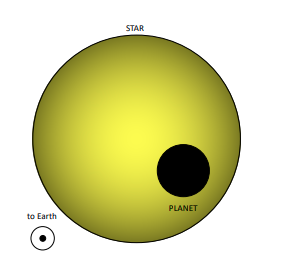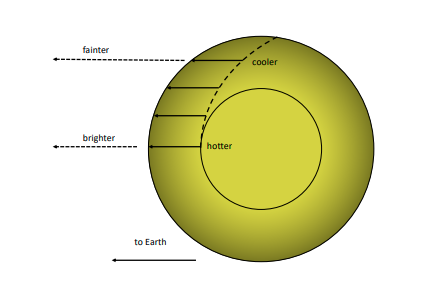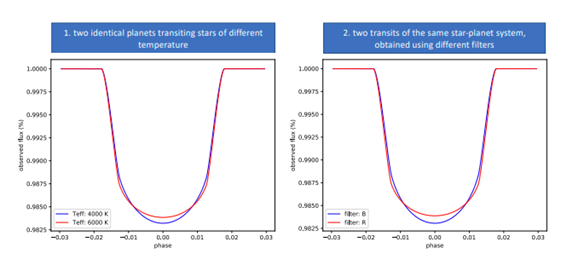The effect of Stellar limb-darkening on transit light curves
There are two main bodies involved in modeling a transit phenomenon: the star and the planet. We begin this educational journey by describing the stellar part of the transit model.
Under certain circumstances related to the planet’s orbit, we will observe the planet passing in front of the star, as illustrated below:

Both the star and the planet have specific characteristics that play a role and influence the phenomenon of transit and how it will be observed by us, the observers.
Let’s see how the star affects the transit: the effect of darkening the edges of the star or “limb-darkening”.
As you can see in the figure above, the stellar disk does not look uniform, it becomes darker as we move away from the center of the disk. Light from the edge of the disk travels a longer distance within the star’s atmosphere compared to light coming from the center of the disk. Because of this, the edge light will originate from a higher altitude in the atmospheres of stars. The temperature will be lower and so this light will be dimmer.

The strength of the darkening of the edges depends on the physical parameters of the star (temperature of the host star, stellar gravity, stellar metallicity) and the filter with which we are observing. Therefore, it is important to specify the observation filter for each transit that is uploaded to the different platforms dedicated to the observation of exoplanet transits.
But how does the darkening of the edges affect traffic? The weaker the darkening of the limbs, the more uniform the stellar disk will be. This will produce a transit with a sharper entry and exit.
Two factors that affect the darkening of the edges in the observations
1. The nature of the star
Hotter stars have a fainter limb darkening. So if we observe, with the same filter, two similar planets transiting around two different stars, the transit around the hotter star will look different.
2. The observation filter
In addition, when the same star-planet system is observed at longer wavelengths, a darkening of the limbs will occur, it will be weaker, and the transit will look sharper. This is one of the reasons why we prefer to observe red filter transits, as sharper transits give a better estimate of transit time.

Further reading:
One of the best ways we have to model this effect is the so-called law of 4 coefficients:

where I is the brightness of the stellar disk at a specific point, relative to the brightness at the
center, μ is the cosine of the angle of view (see figure below) and a1,2,3,4 are the coefficients of darkening of the limbs. You can find more information about this formula and others in these documents:
– https://iopscience.iop.org/article/10.3847/1538-3881/aa8405/pdf
– http://articles.adsabs.harvard.edu/pdf/2000A%26A…363.1081C

